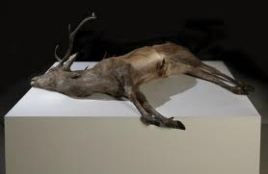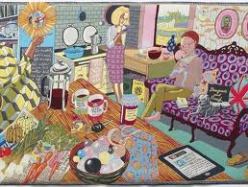Hide and Fight, 2012
Polly Morgan’s Endless Plains at the All Visual Arts gallery, as you might glean from Hide and Fight, above, is morbid. H&F hits you like a rifle slug as you enter the darkened display room of AVA, the massive carcass of the taxidermied stag sprawled on a white, under-lit platform, every hair and pore preserved in harrowing detail. This isn’t just an exercise in traditional trophy taxidermy – peer closer, if you dare, and inside the stags’ stomach is a colony of bats, hanging upside down, bathed in an uncanny green light.
‘The cycle of one life for dozens,’ ‘the uncompromising cycle of life; the predator, the parasite and the prey,’ as the gallery blurb puts it, is most successfully rendered in H&F; The other three fleshy sculptures don’t quite pack the same punch. A litter of piglets scrabble over each other to suck the sap from a fallen tree truck, on which psychedelic mushroom ominously sprout, in The Fall, which falls short not on conception, but on execution, as the piglets have somehow come out of the taxidermic process just a little too shiny; they don’t look real, and these pieces live or die by their ability to convince the viewer that they are authentic scenes from a perverted natural world.
The mushroom make good on their threat in Archipelago, where they now sprout from the split belly of a dead piglet, picked at by a flock of the small birds that dot every sculpture. Again, sorry, Babe, but I don’t buy you. Morgan’s animal corpses have either died from natural causes or are found road kill, of which she keep detailed logs, so intellectually I know I’m looking at a real dead body, but the second of doubt I experience dulls the impact of what otherwise would be a strange and haunting work.
The octopus tentacles wrapped around and sprouting from the dead fox in Habour, again picked at by small, floating birds, are unsettling, and call to mind the tradition of Japanese shunga (erotic art) that feature mythical tentacled sea creatures wrapped around human bodies.
The Dream of the Fisherman’s Wife, 1814 (Hokusai)
I was also reminded of Yumiko Utsus’ Octopus Portrait, currently on show at the Saatchi Gallery (http://www.saatchi-gallery.co.uk/artists/yumiko_utsu.htm?section_name=photography), which features another octopus, or at least octopus relative, that I wouldn’t want to mess with.
The series of drawings of birds’ nest, made from cremated bird remains and each featuring the body of its eponymous feathered subject collapsed on its frame, did little for me, though some might like the juxtaposition of these miniatures against the maxiture of Morgans’ sculptural tableaux of mortality.
Time waits for neither beast nor man. Morgan’s exhibition closes next month.
Keep up with my blog – follow me on Twitter @bitesizedmary



